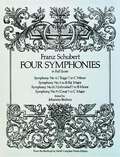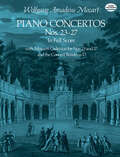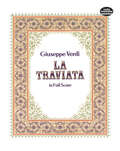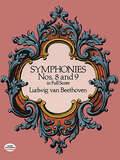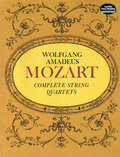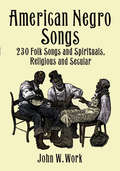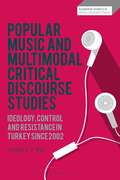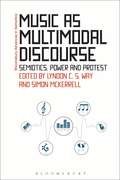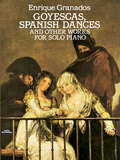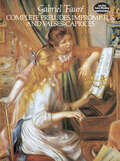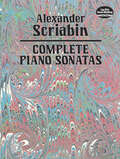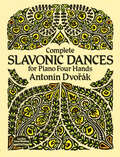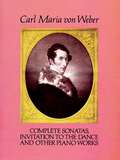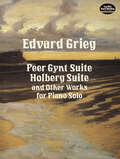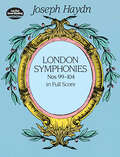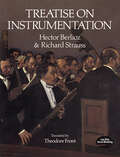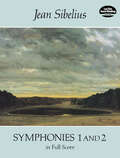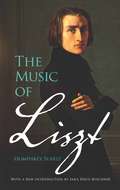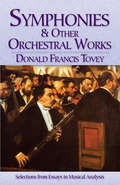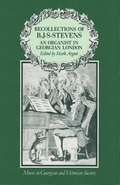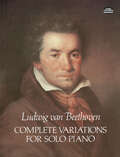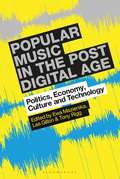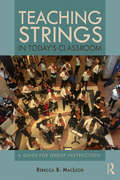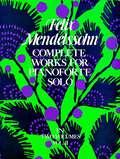- Table View
- List View
Four Symphonies: In Full Score
by Franz SchubertIn 1978 the music world commemorated the 150th anniversary of Schubert's death, and his great symphonies were widely played and recorded. In this one volume are Schubert's four most popular and most often played symphonies in full score, including the Symphony No. 9, which, according to Grove's Dictionary, is "universally admitted to be his greatest masterpiece." The symphonies are reproduced complete and unabridged from the famous and scholarly Breitkopf & Härtel series, a large and eminently readable edition, and are edited by Brahms. No other single-volume edition of these works is currently available.Included in this book are:Symphony No. 4 ("Tragic") in C MinorSymphony No. 5 in B-flat Major (also known as "Symphony without Trumpets and Drums")Symphony No. 8 ("Unfinished) in B MinorSymphony No. 9 ("Great) in C MajorThe music has been reproduced in a size large enough to be read easily, with large noteheads, wide margins (for notes, annotations, etc.), and on opaque paper with sturdy, sewn bindings. Pages lie flat and will not fall out. The edition is practical for almost any use, whether as a study guide, a reference, or simply a companion for your greater musical enjoyment.
Piano Concertos: Nos. 23-27 in Full Score
by Wolfgang Amadeus MozartThis volume contains Mozart's last five piano concertos: No. 23 in A Major, K488; No. 24 in C Minor, K491; No. 25 in C Major, K503; No. 26 in D Major, K537; and No. 27 in B-flat Major, K595. As a bonus in the piano-plus-orchestra genre, the brief Concert Rondo in D Major, K382, has been added along with Mozart's own cadenzas for Nos. 23 and 27.The music is photographically reprinted from the Breitkopf & Härtel text, still considered the standard, authoritative edition for the Mozart concertos. Noteheads in this edition are large enough to be read easily, and margins and spaces between staves permit written notes, harmonic analysis, fingerings, and running measure numbers.Since Mozart's piano concertos are frequently performed in concert and there are several recordings currently available for each of these pieces, this edition is extremely useful for study, reference, and enjoyment.
La Traviata: In Full Score
by Giuseppe VerdiOne of Verdi's most popular opera, La Traviata is based on La Dame aux Camélias ("Camille"), the novel and play by Alexandre Dumas, fils that enthralled Parisian audiences of the 1850s with a stirring portrayal of a beautiful courtesan redeemed by love. With his librettist, Francesco Maria Piave, Verdi transformed the Dumas story of a passionate, ultimately poignant love affair within the intoxicating demimonde of Paris in the mid-1800s to an exciting, deeply moving musical drama.La Traviata fortunately survived its dismal first production in Venice in 1853 to become a worldwide favorite, treasured by musical artists and audiences alike for the lyric beauty of its arias and ensembles, and for the dramatic force and finesse of its orchestral scoring. This full-score edition, designed to provide a lifetime of study and enjoyment, is reproduced from the authoritative edition prepared for G. Ricordi of Milan. It will afford opera lovers a rare opportunity to study intimately Verdi's genius for operatic composition in the early years of its greatest flowering.
Symphonies Nos. 8 and 9: In Full Score
by Ludwig Van BeethovenBeethoven's symphonies are among his greatest works -- in the opinion of many, the greatest orchestral compositions in the history of music. Perfect in their fusion of emotion and form, filled with drama and great beauty, they are among the best-known and best-loved works in all classical music. This volume contains complete scores for Symphony No. 8 in F Major, Op. 93, and Symphony No. 9 in D Minor, Op. 125.The eighth is full of beauty and innocent merriment, while the ninth is Beethoven's best and greatest symphony, a dazzling end to his symphonic works. Also included here is a translation of the passage from Schiller's ode "To Joy," featured in the last movement. Meticulously reproduced from the authoritative Litolff edition, each score features large, clear noteheads and wide margins for ease of use in studying and following the music. Far less expensive than comparable full-score editions, this volume belongs in the library of any music lover who wishes to study the masterly innovation and creativity Beethoven brought to the symphonic form.
Complete String Quartets
by Wolfgang Amadeus MozartThis single volume contains all the string quartets of Mozart: the little-known early quartets in an Italianate manner composed between 1770 and 1773: the six quartets dedicated to Franz Josef Haydn (1782-85); the D Major Quartet (K.499) composed in 1786; and the last three quartets (1789-90) written for the King of Prussia. In addition to the 23 string quartets, the volume contains an alternate slow movement to the G Major Quartet, K. 156.The music is photographically reprinted from the Breitkopf & Härtel printed score, still considered the standard, authoritative edition for the Mozart quartets.Noteheads in this edition have been reproduced in a size large enough to be read easily from a music stand or the keyboard, and margins and spaces between staves are conveniently wide to permit written notes, harmonic analysis, fingerings, and running measure numbers. This edition is practical for study, reference, enjoyment -- virtually any use.
American Negro Songs: 230 Folk Songs and Spirituals, Religious and Secular
by John W. WorkFrom joyous gospel to deeply felt blues, this wonderful collection contains vintage songs sung and played through the years by black Americans — at work, in church, and for pure entertainment. Included are spirituals, blues, work songs, and a variety of social and dance songs.This important volume was originally compiled in 1940 by Dr. John W. Work, the noted musicologist affiliated with Fisk University and the celebrated Fisk Jubilee Singers. In it, he discusses the origins and history of black American folk music, the influence of slavery and African cultures, and the lyric significance of such much-loved songs as "Swing Low, Sweet Chariot," Steal Away to Jesus," "Lord, I Want to Be a Christian," and "John Henry." These informative notes lead up to the heart of the book: the complete words and music for 230 religious and secular songs, including "Study War No More," "Keep Me from Sinking Down," "You May Bury Me in the East," "Rock of Ages," "Go Tell It on the Mountain," and many others.This is an indispensable treasury of music for singers, musicians and all readers seeking a comprehensive sourcebook of black American folk music. It will be equally welcomed at parties, family get-togethers, sing-alongs, church events, and other gatherings where people want to play and sing these classic folk songs that are an integral part of American musical history.
Popular Music and Multimodal Critical Discourse Studies: Ideology, Control and Resistance in Turkey since 2002 (Bloomsbury Advances in Critical Discourse Studies)
by Lyndon C. WayPopular music has long been used to entertain, provoke, challenge and liberate but also to oppress and control. Can popular music be political? What types of popular music work best with politics? How can songs, videos, concerts or any other musical commodity convey ideas about power, politics and identity?Using Multimodal Critical Discourse Studies (MCDS), this book reveals the deeply political role played by popular music. Lyndon Way demonstrates how MCDS can provide important and timely insights on the political nature of popular music, due to its focus on how communication takes place, as well as its interest in discourse and how ideologies are naturalised and legitimised. The book considers the example of contemporary Turkish society, with its complex and deep ideological divisions increasingly obvious under the stewardship of President Recep Tayyip Erdogan and his centre-right political party, in power since 2002. It looks at how the authorities seek to harness and control popular music and considers a wide range of popular music genres including rock, rap, protest and folk music. It shows how official promotional videos, protest cut-and-paste offerings, party-political election songs, live music events and internet discussions about popular music emerge as sites of power and resistance in certain venues and particularly across social media. Throughout the book, Lyndon Way shows that popular music is also deeply political.
Music as Multimodal Discourse: Semiotics, Power and Protest (Bloomsbury Advances in Semiotics)
by Lyndon C. Way Simon McKerrellWe communicate multimodally. Everyday communication involves not only words, but gestures, images, videos, sounds and of course, music. Music has traditionally been viewed as a separate object that we can isolate, discuss, perform and listen to. However, much of music's power lies in its use as multimodal communication. It is not just lyrics which lend songs their meaning, but images and musical sounds as well. The music industry, governments and artists have always relied on posters, films and album covers to enhance music's semiotic meaning. Music as Multimodal Discourse: Semiotics, Power and Protest considers musical sound as multimodal communication, examining the interacting meaning potential of sonic aspects such as rhythm, instrumentation, pitch, tonality, melody and their interrelationships with text, image and other modes, drawing upon, and extending the conceptual territory of social semiotics. In so doing, this book brings together research from scholars to explore questions around how we communicate through musical discourse, and in the discourses of music. Methods in this collection are drawn from Critical Discourse Analysis, Social Semiotics and Music Studies to expose both the function and semiotic potential of the various modes used in songs and other musical texts. These analyses reveal how each mode works in various contexts from around the world often articulating counter-hegemonic and subversive discourses of identity and belonging.
Goyescas, Spanish Dances and Other Works for Solo Piano
by Enrique GranadosThis remarkable book brings together in one sturdy, yet inexpensive volume four of the most memorable and frequently played sets of works for the piano by Enrique Granados (1867-1916), one of Spain's greatest modern composers. They are reprinted here from early editions.The piano suite Goyescas, first performed in Barcelona in 1911, would bring Granados his greatest, most enduring success. In each of its six pieces, the composer employs wild, insistent melody and highly individual rhythm, harmony, and coloring to create dramatic impressions of paintings by Goya, to whose work Granados was deeply drawn.The exquisite Spanish Dances, a suite of early works, were much admired by the leading composers of the day, among them Massenet, Saint-Saëns, and Grieg, not only for their distinctive musical qualities, but also for the new direction in Spanish music which they heralded. They remain today perhaps the most performed of Granados's work.Less well known in America are the beautiful Escenas poéticas and Escenas románticas, two suites which reflect Granados's interest in the music of Grieg, Schumann, and Liszt, yet are filled with the great Spanish composer's original modulations and characteristic melodic writing. Together, the four suites offer performing artists, teachers, students, and music lovers a rich treasury of the finest and most enduring of Granados's compositions for the piano.
Complete Preludes, Impromptus and Valses-Caprices
by Gabriel FauréGabriel Fauré (1845-1924) enriched the literature of the piano with freshly melodic, elegantly wrought compositions that embody the aristocratic qualities of the French tradition. This superbly produced volume brings together in one authoritative playing edition one of the most important segments of his works for piano: all of his nine Preludes, five Impromptus, and four Valses-Caprices.Each of these distinctive compositions, so often heard today in concert and recital halls around the world and frequently recorded by leading pianists, reveal Fauré's lyrical melodic gifts and innovative harmonies and the classical qualities of clarity, balance, and serenity characteristic of his work.Pianists of intermediate and advanced skills will find in these richly varied compositions -- unavailable elsewhere in one volume -- a unique opportunity to explore the elegant artistry of one of the most gifted and influential composers of the French school. Music lovers at every level of accomplishment will discover in this well-made, yet inexpensive edition a most satisfying way to savor fine music: to follow phrase by phrase, music in hand, a live or recorded performance.
Complete Piano Sonatas
by Alexander ScriabinLike Chopin, Scriabin made the piano the focus of his art. Among the supreme achievements of that art are the ten sonatas he composed between 1892 and 1913, works that abundantly display both his technical virtuosity and the exhilarating emotional gamut he ranged with such individuality.All ten of Scriabin's sonatas are reprinted here from the authoritative Russian edition published in 1964. The first four reveal the influences of the pianism of Chopin and Liszt. The subsequent sonatas richly display Scriabin's emerging impressionist techniques and his deep attraction to mysticism, which progressively conjured a more and more ethereal framework of sound, now brooding and introspective, now rhapsodic and exultant.In both their technical requirements and their emotional demands, these brilliant works will offer pianists a deeply satisfying challenge. Nonpianists will also enjoy this finely made edition, with which they may follow, music in hand, the growing number of loved and recorded performances of these masterpieces.
Complete Slavonic Dances for Piano Four Hands
by Antonin DvorákThe two series of piano duets combined in this volume are among Dvořák's most famous compositions and among the most performed works in the piano four hands repertoire. The composer intended them as artistic stylizations of typical Slavonic dances such as the furiant, the dumka, the polka, the skočná, the odzemek, and the kolo.The first series of eight dances, Opus 46 (1878), is full of joy and vitality. The second set of eight dances, Opus 72 (1886), is slightly more somber and meditative. Both series will delight pianists with their exciting rhythms and fresh, highly individual invention. They are reprinted here from the authoritative Czechoslovakian editions of Dvořák's complete works.
Complete Sonatas, Invitation to the Dance and Other Piano Works
by Carl Maria WeberA virtuoso of the piano and a pioneer of musical Romanticism, Carl Maria von Wolfe (1786-1926) wrote piano music of elegance and grandeur enhanced with bravura technical effects that profoundly influenced later 19th-century piano music. This volume presents virtually all Weber's works for piano solo: the four piano sonatas -- Opus 24 in C Major (1812), Opus 39 in A-flat Minor (1816), Opus 49 in D Minor (1816), and Opus 70 in E Minor (1822) -- considered the core of his output; his most popular piano composition, Invitation to the Dance, a waltz later orchestrated by Berlioz and used for the celebrated ballet Le Spectre de la Rose; eight lively and engaging sets of variations; and the dazzling Momento Capriccioso, Grande Polonaise, Rondo Brillante, and Polacca Brillante. Pianists will enjoy exploring this richly varied collection of piano masterworks, reprinted from the authoritative edition published by C. F. Peters of Leipzig.
Peer Gynt Suite, Holberg Suite, and Other Works for Piano Solo
by Edvard GriegTreasury of piano music by great Norwegian composer, including the perennial favorites, Peer Gynt Suites Nos. 1 and 2 and the Holberg Suite, as well as a rich selection of other pieces: Vier Stucke, Op. 1, Humoresker, Op. 6, Sonata in E Minor, Op. 7, Zwei elegische Melodien, Op. 34, Stimmungen, Op. 73 and many others. Authoritative C. F. Peters edition.
London Symphonies Nos. 99-104 in Full Score
by Joseph HaydnIt was in his monumental 12 "London" symphonies, composed between 1791 and 1795, that Haydn shaped the early form of the symphony and set the standard for later composers. According to the New Grove's Dictionary of Music and Musicians, the appeal of these works stems from their stature as "grand" symphonies, embodying a "broader presentation of musical ideas" and "themes and motifs of a basic simplicity and immediate appeal."The present volume contains the last six symphonies in the series, including the lively "Military" Symphony (No. 100), the delightful "Clock" Symphony (No. 101), and the world-famous "London" Symphony (No. 104).Scores included in this volume are Symphony No. 99 in E-flat Major; Symphony No. 100 in G Major ("Military"); Symphony No. 101 in D Major ("The Clock"); Symphony No. 102 in B-flat Major; Symphony No. 103 in E-flat Major ("Dumroll"); and Symphony No. 104 in D Major ("London").The attractive qualities of these works have made them perennial favorites with musicians and concertgoers for over two hundred years. Now music lovers can study and enjoy the elegant structure and polished orchestration of these enduring masterpieces in this authoritative full-score edition.
Piano Technique
by Walter Gieseking Karl LeimerThe volume presents two book by Walter Gieseking, foremost pianist of his generation, and his teacher for five years, Karl Leimer, that have long been sought after by students and teachers looking for a radical approach toward developing not only finger-technique but expression-technique. Emphasis throughout is on listening to one's self and proper understanding as the basis of proper technique for the piano.In book one, originally titled The Shortest Way to Pianistic Perfection, Gieseking and Leimer work with a series of piano works -- a study from Lebert and Stark, Bach's Two- and Three-Part Inventions in C, and Beethoven's Sonata in F Minor, Op. 2, No. 1. Before beginning to play, the student is asked to visualize each piece through silent reading. Through Leimer's instruction in this area the student soon discovers how to approach each piece as not merely a series of notes to memorize but as a coherent musical structure to understand. Following are instructions on natural interpretation, with consideration of touch, relaxation, and proper emphasis in the practice. Also given are notes on such topics as etudes, scales, broken chords, the trill, and tranquility.In book two, Rhythmics, Dynamics, Pedal and Other Problems of Piano Playing, Leimer carries his method of visualization further with a study of the Allemande from Bach's French Suite in E Major. Following are further exercises and practices for developing other pianistic technique with reference to works of other composers. Specific exercises which cover rhythmics, dynamics, and phrasing are designed so that they will benefit not only the pianist but also performers on other instruments. Extensive chapters on variety of touch and the pedal give a great number of techniques and exercises for extending the expressive and dynamic range.
Treatise on Instrumentation
by Hector Berlioz Richard StraussThe most influential work of its kind ever written, appraising the musical qualities and potential of over 60 commonly used stringed, wind and percussion instruments. With 150 illustrative full-score musical examples from works by Berlioz, Mozart, Beethoven, Gluck, Weber, Wagner, and others, and numerous smaller musical examples. Complete with Berlioz' chapters on the orchestra and on conducting. Translated by Theodore Front. Foreword by Richard Strauss. Glossary.
Symphonies 1 and 2: In Full Score
by Jean SibeliusFinland's greatest composer and a major figure in the development of Scandinavian music, Jean Sibelius (1865-1957) is admired for his complete mastery of symphonic form. Of the seven symphonies he composed, each differs greatly from the others, for Sibelius rarely approached the symphonic "problem" the same way. Each work seems committed to the thoughts, feelings, and logic of the movement.Sibelius's first two symphonies remain among his most accessible and popular. Of all his symphonic works, perhaps the First Symphony, composed in 1898-99, adheres most to classical form yet reflects the spirit of Nordic nationalism that came to be associated with the composer's music.The Second Symphony, perhaps his most expansive and melodious work in symphonic form, demonstrates Sibelius's increasing command of orchestral form and scoring. These two major works are reprinted here from the definitive full-score editions published by Breitkopf & Härtel, Leipzig.
The Music of Liszt
by Humphrey Searle Sara Davis BuechnerVirtuoso pianist Franz Liszt was a key figure in the evolution of modern music. Most of his 700 compositions, which range from romantic impressionism to daring experimental pieces, were written for the piano. This survey by a well-known British composer and musicologist constitutes the most authoritative English-language study of Liszt's works. "Mr. Searle is himself a composer of progressive outlook and he thus speaks with authority. His book was needed and he has made it a good one," observed the Times (London) Literary Supplement. This classic study surveys the compositions in chronological order and the medium for which they were written. The author examines in detail the most important pieces and fully reviews Liszt's place in history. Subjects include romantic pieces, symphonic poems, songs, symphonies, and other works. A biographical summary illustrates the relationship between significant works and events in the composer's life. Acclaimed by Library Journal as "a balanced, long-overdue treatment," this study is essential for every true Lisztian student.
Symphonies and Other Orchestral Works: Selections from Essays in Musical Analysis
by Donald Francis ToveyMore than 100 selections from the noted musicologist's Essays in Musical Analysis cover most of the standard works in the symphonic repertory. Subjects include Beethoven's overtures and symphonies, including the author's famous study of the Ninth Symphony; all Brahms's overtures and symphonies; 11 symphonies by Haydn; six by Mozart; three symphonies each by Schubert, Schumann, and Sibelius; four symphonies by Dvoràk; and many other works by composers from Bach to Vaughan Williams.Donald Francis Tovey's Essays in Musical Analysis ranks among the English language's most acclaimed works of musical criticism. Praised for their acuteness, common sense, clarity, and wit, they offer entertaining and instructive reading for anyone interested in the classical music repertoire.
Recollections Of R. J. S. Stevens: An Organist In Georgian London (Music In Georgian And Victorian Society Ser. (PDF))
by Mark ArgentR.J.S.Stevens was an organist, composer and singer, active in late eighteenth- and early nineteenth-century London. His Recollections give a fascinating glimpse of the life of an ordinary musician as he went about his daily business serving as a church organist, singing glees - occasionally with the Prince of Wales - and teaching. They show how the events of his time bore, or failed to bear, on the lives of ordinary people, and present an entertaining insider's view of the famous musical institutions of London, including the Anacreontic Society, whose club song is now The Star-Spangled Banner, the national anthem of the USA.
Complete Variations for Solo Piano
by Ludwig Van BeethovenThe piano music of Beethoven is an indispensable part of the repertoire of any serious pianist. Especially appealing are the variations, magnificent compositions second only to the sonatas and concertos in importance, and among the most recorded and performed music in the piano literature.This volume contains all 21 sets of Beethoven's solo piano variations, including the extremely popular Diabelli Variations, Op. 120, which, in the view of many critics, accomplished for the piano what Bach's Goldberg Variations did for the harpsichord. Also included are the perennially admired Thirty-two Variations in C Minor, the Eroica Variations, Op. 35, and a treasury of variations on themes by Dressler, Salieri, Süssmayr, Righini, and other composers.Reprinted from the authoritative Breitkopf & Härtel edition, this music manifests the prodigious invention and imagination the master brought to the variation form. Now the complete corpus of variations is available in this inexpensive reliable edition, ready to inspire and challenge pianists and music lovers.
Popular Music in the Post-Digital Age: Politics, Economy, Culture and Technology
by Les Gillon Professor Ewa Mazierska Tony RiggPopular Music in the Post-Digital Age explores the relationship between macro environmental factors, such as politics, economics, culture and technology, captured by terms such as 'post-digital' and 'post-internet'. It also discusses the creation, monetisation and consumption of music and what changes in the music industry can tell us about wider shifts in economy and culture. This collection of 13 case studies covers issues such as curation algorithms, blockchain, careers of mainstream and independent musicians, festivals and clubs-to inform greater understanding and better navigation of the popular music landscape within a global context.
Teaching Strings in Today's Classroom: A Guide for Group Instruction
by Rebecca B. MacLeodTeaching Strings in Today’s Classroom: A Guide for Group Instruction assists music education students, in-service teachers, and performers to realize their goals of becoming effective string educators. It introduces readers to the school orchestra environment, presents the foundational concepts needed to teach strings, and provides opportunities for the reader to apply this information. The author describes how becoming an effective string teacher requires three things of equal importance: content knowledge, performance skills, and opportunities to apply the content knowledge and performance skills in a teaching situation. In two parts, the text addresses the unique context that is teaching strings, a practice with its own objectives and related teaching strategies. Part I (Foundations of Teaching and Learning String Instruments) first presents an overview of the string teaching environment, encouraging the reader to consider how context impacts teaching, followed by practical discussions of instrument sizing and position, chapters on the development of each hand, and instruction for best practices concerning tone production, articulation, and bowing guidelines. Part II (Understanding Fingerings) provides clear guidance for understanding basic finger patterns, positions, and the creation of logical fingerings. String fingerings are abstract and thus difficult to negotiate without years of playing experience—these chapters (and their corresponding interactive online tutorials) distill the content knowledge required to understand string fingerings in a way that non-string players can understand and use. Teaching Strings in Today’s Classroom contains pedagogical information, performance activities, and an online virtual teaching environment with twelve interactive tutorials, three for each of the four string instruments.
Complete Works for Pianoforte Solo: Volume II
by Felix MendelssohnMendelssohn's complete works for pianoforte solo are now contained in this two-volume republication of the outstanding Breitkopf & Härtel edition. Included in Volume One are: "Capriccio in F-sharp Minor" (1825), "Sonata in E Major" (1826), Seven Characteristic Pieces," "Rondo Capriccioso in E Major" (1824), "Fantasy in F-sharp Minor" (1835), "Andante cantabile e Presto agitato in B Major" (1838), "Etude in F Minor" (1836), "Scherzo in B Minor," "Gondola Song in A Major" (1837), "Scherzo a Capriccio in F-sharp Minor," "Three Caprices" (1833-1835), "Six Preludes and Fugues" (1827-1837), "Variations Sérieuses in D Minor" (1841), "Six Pieces for Children" (c. 1842), "Variations in E-flat Major" (1841), and Variations in B-flat Major."Volume Two contains: "Three Predules" (1836), "Three Etudes" (1834-1838), "Sonata in G Minor" (1821), "Sonata in B-flat Major" (1827), "Album Leaf (Song Without Words) in E Minor," "Capriccio in E Major/Minor" (1837), "Perpetuum Mobile in C Major," "Prelude and Fugue in E Minor" (1827, 1841), "Two Pieces," and "Song Without Words" [48 pieces in 8 books].Noteheads have been reproduced in a size large enough to be read easily at the keyboard. Margins and spaces between staves are generous, permitting insertion of written notes, analysis, fingerings, running measure numbers, etc. For playing, study, or just listening to records, this work will be an admirable addition to your music library.
